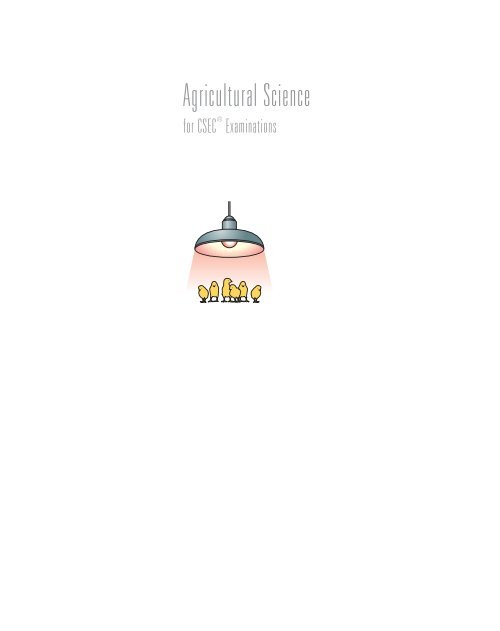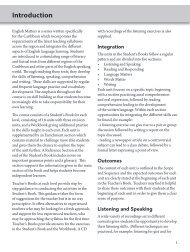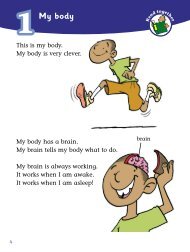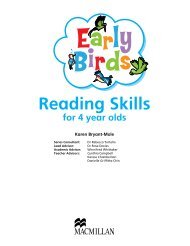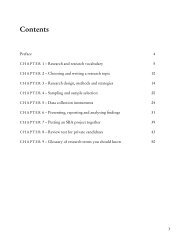Agricultural Science - Macmillan Caribbean
Agricultural Science - Macmillan Caribbean
Agricultural Science - Macmillan Caribbean
Create successful ePaper yourself
Turn your PDF publications into a flip-book with our unique Google optimized e-Paper software.
Contents8.6 The factors affecting soil fertility 1068.7 Importance of minor nutrients in crop production 1088.8 Fertiliser ratio 1098.9 Maintaining soil fertility 1108.10 Composting 1138.11 Soil erosion 1148.12 Different types of soil erosion 1148.13 The causes of soil erosion 1158.14 Soil and water conservation methods 1169 Land preparation 1259.1 The relationship between climate and agricultural production 1269.2 Measuring rainfall and temperature 1279.3 Interpreting weather records 1299.4 Weather records and farming decisions 1319.5 Land preparation methods 1319.6 Machinery used in crop husbandry 1359.7 Care and maintenance 1389.8 Safety precautions when operating tools, machinery and equipment 13910 Plant morphology and physiology 14410.1 The structure of plants 14510.2 Sexual and asexual reproduction in plants 15110.3 Sexual and asexual reproduction in relation to crop production 15610.4 Seed germination 15710.5 Plant processes 16410.6 Environmental factors and plant growth and development 16711 Plant genetics, breeding and biotechnology 17411.1 The principles of genetic inheritance 17511.2 Plant breeding 17811.3 Biotechnology in plant improvement 18112 Crop husbandry 18612.1 Cropping systems 18712.2 Cultural practices associated with crop production 18912.3 The effects of weeds on crops 19012.4 Methods of weed control 19112.5 Pests and crop damage 19312.6 Major crop diseases 19512.7 Pest and disease management 19712.8 Chemicals in the environment 19812.9 Cultivation of vegetable crops 20012.10 Plant quarantine 20313 Harvesting and post-harvest practices 20813.1 Post-harvest technology 20913.2 Harvesting crops 20913.3 Harvesting methods 21013.4 Harvest and post-harvest practices for ornamentals 21113.5 From the farm to the table 21214 Processing and utilisation 21614.1 Reasons for processing crops 21714.2 Food processing techniques 21714.3 Utilisation of processed products 222viCSEC Agriculture Prelims prf5.indd 6 02/03/2011 2:28 PM
ContentsSection C: Animal Production15 Morphology and physiology 22515.1 The digestive system of a bird 22615.2 Ruminant and non-ruminant digestive systems 22815.3 Functions of the digestive system parts 22815.4 The process of digestion 22915.5 Digestion in rabbits 23115.6 The structure of an egg 23116 Nutrition 23516.1 Nutrients in animal nutrition 23616.2 The balanced ration 23816.3 Appropriate rations for livestock 23916.4 Feed conversion ratio (FCR) 24016.5 The importance of FCR 24016.6 Systems of grazing 24116.7 The advantages and disadvantages of different grazing systems 24316.8 The importance of forages in livestock feeding 24416.9 Forage conservation 24717 Housing 25217.1 Housing requirements for farm animals 25317.2 Housing for broilers, layers and rabbits 25417.3 Bee production and fish farming 25618 Animal genetics, breeding and reproduction 26318.1 Breeds of farm animals 26418.2 Uses of different breeds of farm animals 26518.3 Animal genetics 26618.4 Breeding systems in animal production 26718.5 The advantages of cross-breeding 26818.6 The principles of genetic improvement 26918.7 Artificial insemination in farm animals 27018.8 Advantages and disadvantages of artificial insemination 27118.9 Terms used in animal reproduction 27218.10 Egg formation and incubation in poultry 27418.11 Embryo transfer 27618.12 Genetic engineering in livestock production 27819 Animal husbandry 28519.1 The care of young chicks and rabbits 28619.2 Management practices associated with rearing broilers, layers and rabbits 28819.3 Rearing a batch of broilers 28919.4 Animal health 28919.5 Pests and diseases of poultry and rabbits: symptoms, prevention and control 29019.6 The economic importance of bees 29119.7 The types of bees in a hive 29219.8 The social activities of bees 29219.9 Pests and diseases of bees 29319.10 Honey and other bee products 29420 Animal products technology 30020.1 Animal products and by-products 30120.2 The dressing percentage of farm animals 30420.3 The slaughter of broilers 30520.4 The marketing of eggs and meat 306viiCSEC Agriculture Prelims prf5.indd 7 02/03/2011 2:28 PM
ContentsSection D: Horticulture (Double Award only)21 Horticulture 31021.1 What is meant by horticulture? 31121.2 The importance of horticultural plants 31221.3 The cultivation of horticultural plants 31221.4 Harvesting techniques of horticultural plants 31621.5 Quality requirements for flowers 31621.6 The establishment of lawn and turf grasses 317Section E: Animal Management (Double Award only)22 Animal management 32122.1 Management practices in the rearing of livestock 32222.2 Preventing food spoilage 33022.3 Principal cuts of meat 33222.4 The quality requirements of meat 33222.5 Safety requirements in the processing of food 33322.6 Value-added products 33322.7 The role of biotechnology in animal production 335School-based Assessment (SBA) component 339Answers to multiple choice questions 372Index 373viiiCSEC Agriculture Prelims prf5.indd 8 02/03/2011 2:28 PM
Series prefaceThis series of textbooks for the <strong>Caribbean</strong> Examinations Council [CXC] examinationshas been developed and written by teachers with many years’ experienceof preparing students for CSEC examinations in <strong>Caribbean</strong> schools. Thisbook can be used for either the Single or Double Award.A textbook is used in different ways at different times.▸ Readers may be starting a topic from scratch and need to be led through alogical explanation one step at a time.▸ Students with a working knowledge of a topic may need to clarify a detail, orreinforce their understanding. Or, they may simply need to believe that theydo have a good grasp of the material.The specially created format is the same for all books in the series. Diagramsand pictures are placed on the page in such a way that they can be consultedas the reader wishes, but interrupt the text as little as possible.▸ Short answer questions (called In-Text Questions, even though they are notplaced in the main body of the page) allow the student to test his or her graspof the topic. A student who can answer an ITQ gains confidence; a studentwho cannot knows to go back over the topic and try again.▸ Important technical terms are highlighted in the margin where they are firstused. This emphasises their importance and makes an index-based searcheasier to do.Teachers throughout the region have emphasised that inclusion of SBA materialis important for these books. Each CSEC syllabus specifies the type ofSBA exercise that is expected. This subject may be studied at Single Award orDouble Award level; the SBA requirements differ. Accordingly, a chapter offeringdetailed advice for both is included.Dr Mike TaylorSeries EditorixCSEC Agriculture Prelims prf5.indd 9 02/03/2011 2:28 PM
About this bookThis book isn’t just words on a page. Here are some important features. Eachwill help you, if you take advantage of it.▸ There are two columns. The bigger column has the text and some really largediagrams; you can read straight down it without interruption. The smallercolumn has other diagrams which the text mentions. Look at them carefullyas you need them. You may find that looking at a diagram for a few secondsis worth a few minutes of reading.▸ The first time that an important new word occurs, it is repeated in the smallercolumn. If you want to check what a word means, you can find it quickly.▸ There are questions called ITQs (In-Text Questions). When you have read thenearby text, try to answer the question, in your head or on paper. If you can,you’re on the road to understanding. If you can’t, just go back and read thatbit again. Answers to ITQs are at the end of each chapter, so you can tell howgood your answer was.▸ At the end of each chapter there are some examination-style questions. Yourteacher will suggest how you can use them. Some are multiple choice questions,and the answers to these can be found at the end of the book.▸ Whether for the Single or the Double Award, you have to present an SBAinvolving practical work and the production of a record of what you havedone, including a financial analysis. The last chapter has a detailed explanationof what is expected, an explanation of how you might set about thepractical work and what is important in it.▸ There is a detailed index. Don’t be afraid to use it to find what you want!xCSEC Agriculture Prelims prf5.indd 10 02/03/2011 2:28 PM
1T h e r o l e a n d i m p o r t a n c e o fa g r i c u l t u r eBy the end ofthis chapteryou should beable to:✓ understand that agriculture is important in national, regional and internationaleconomies✓ list the various career opportunities and levels of training in the agriculturalsector✓ know and understand the functions of local, regional and internationalinstitutions concerned with agricultural development in the <strong>Caribbean</strong>.Concept mapRole of agricultureEconomic importanceCareer opportunities<strong>Agricultural</strong> developmentRegional National InternationalLocal Regional Internationalemploymentfood securitycontributionto GNPforeign exchangetrade liberalisationMinistry ofAgricultureCARICOMCFNICDBCARDIUWICASEECIAFGSAEUIICAFAOOASIDBCIDAjournalismagro-processingcertificationquality controlengineeringfood productioneducationsales and marketingmanagementfood inspectionservices1CSEC Agriculture Sec A prf5.indd 1 02/03/2011 2:29 PM
Section A: The Business of Farming1.1 The importance of agriculture in national,regional and international economiesagriculture ▸ITQ1Distinguish between ‘agriculture’, ‘farming’ and‘husbandry’.ITQ2List as many different types of agriculturalproduction as you can think of, focusing on thosefound in the <strong>Caribbean</strong>.foreign exchange ▸Gross National Product (GNP) ▸food security ▸The word agriculture comes from the Latin agri cultura, meaning ‘cultivation ofthe field’. It covers all the arts, skills, sciences, industries and services used byhumans to obtain food from the land. This includes the cultivation of crops and therearing of livestock, together with the related industries supplying seeds, chemicalfertilisers, machinery, finance and technology. In addition, agriculture involvesmarketing and processing.Often ‘agriculture’ is used to mean the same as ‘farming’ and ‘husbandry’. Butfarming and husbandry have more to do with specific activities such as dairyfarming, crop husbandry, organic farming, livestock husbandry, mixed farmingand exotic farming.Traditionally, agriculture has been recognised as the art of tilling the soil and away of life for families in rural communities. With modern technology and a risingworld population, agriculture today is seen as an art, a skill, an applied science,a multi-faceted discipline, a business and a vocation, focused primarily on foodproduction.Foreign exchange earningsAgriculture is very important to the economies of all <strong>Caribbean</strong> countries, bothregionally and internationally.When <strong>Caribbean</strong> agricultural goods and services are sold to other countries,foreign exchange is earned. For example, the export of bananas and coffeeearns foreign currency. However, when foreign agricultural goods and servicesare imported, <strong>Caribbean</strong> currency is converted to foreign exchange; importingagricultural machinery from abroad is therefore a loss to the local community.Contribution to Gross National ProductThe Gross National Product (GNP) is a measure of the current value of goods andservices from all sectors of the national economy. Agriculture is a vital sector of thenational economy and contributes to the GNP.Food securityFood security means being self-sufficient in food. Most <strong>Caribbean</strong> countries arenow boosting their local food production and reducing food imports.In the <strong>Caribbean</strong>, food security is affected by:• low agricultural productivity, resulting from inefficient use of water and otherinputs• a decline in earnings from traditional crops resulting from the loss of tradepreferences• a dependency on imported food resulting from the inability to produce foodlocally at competitive prices• increased poverty in many countries because of a loss of agricultural jobs.Food security can be promoted by initiatives to improve food production andmarketing, expand trade opportunities, increase income and improve nutrition.Employment ratio of imported food to local produceThe agricultural sector can provide employment for many people. There is a widerange of job opportunities, such as farming, agricultural education, marketing,engineering and farm management. Improved agricultural production improvesthe employment prospects of a region – if more food is grown locally then more jobs2CSEC Agriculture Sec A prf5.indd 2 02/03/2011 2:29 PM
1 · The role and importance of agricultureare created. Importing food from abroad reduces the number of local agriculturaljobs.There is also concern about the quality of some of the food imported into the<strong>Caribbean</strong>. It is thought that some imported food may be responsible for an obesityproblem within the population.agricultural plans ▸tariff ▸trade liberalisation ▸ITQ3Make a list of the major roles of agriculture in theeconomy of a country.ITQ4Explain what is meant by ‘food security’.ITQ5How does importing food reduce the number ofjob opportunities?Practical activity:Look at some national, regionaland international statistical reportsabout food production, imports orexports.National and regional plans for agricultural development<strong>Agricultural</strong> plans are policy documents, prepared by governments, private firmsor international organisations, setting out plans for agricultural development.Normally, local or national plans are prepared by the government of each<strong>Caribbean</strong> country for a five-year period. The plan for each country identifiesthe areas of agriculture which need attention and may specify the current status,constraints, strategies and resources required for the development of each area.Carefully prepared plans can bring about agricultural development and nationaldevelopment.Regional plans for agricultural development are produced through the cooperativeefforts of <strong>Caribbean</strong> countries, based on the agricultural needs of theregion. Specific goals, objectives, constraints, strategies, resources and evaluationprocedures help to put the plans into practice.Trade liberalisationTrade liberalisation helps global competitiveness. A fair trade in goods and servicesdevelops through removing tariffs and non-tariff barriers. A tariff is a tax levied by agovernment on imports (or occasionally exports) for purposes of protection, supportof the balance of payments, or the raising of revenue. Global trade liberalisationinitiatives encourage greater efficiency in marketing and trade by restructuringtrade policy regimes to reduce the level of protection from competition.Trade liberalisation does not just depend on the removal of barriers and thenegotiation of better access conditions. It requires rules which define the frameworkfor each government in the formulation of their trade policies. This should result ineach country being encouraged to improve productivity in agriculture and makinggreater efforts to improve the quality of agricultural products.1.2 Career opportunities in agricultureCareers in agriculture include:• food production• sales and marketing• services• food inspection and quality control• agro-processing• engineering• education• journalism• management and administration• certification.Some career areas extend beyond the agricultural sector: sales and marketing,services, engineering, management and administration can all be associated withmany other industries.3CSEC Agriculture Sec A prf5.indd 3 02/03/2011 2:29 PM
Services1 · The role and importance of agricultureThe jobs associated with servicing any industry include technicians, drivers,electricians, plumbers and mechanics. Very few of these jobs require specialistknowledge of agriculture, although some mechanics and technicians may developexpertise in dealing with agricultural machinery.Food inspection and quality controlThese are very important aspects of food production, both for fresh produce andfor processed food. Lack of inspection and poor quality control procedures resultin inferior produce and health hazards. Careers in these areas require trainingand qualifications to at least NVQ or equivalent level. Qualified people may beemployed in agro-processing or by government agencies.Figure 1.2 An agricultural marketstall.Agro-processingAgro-processing involves turning agricultural produce into products (preservedfruits, jams, wines and sauces), which can be marketed locally, nationally orexported. The employment opportunities are numerous. They range from unskilledlabour (in processing and packaging plants) to biochemists and quality assuranceofficers who have professional qualifications.EngineeringAgriculture depends on mechanisation to become more efficient. Transport ofproduce and animals from farms to processing plants is essential and increasinglyprocesses are becoming mechanised. Harvesting of many crops is done bymachinery, rather than by hand. Ploughing, sowing, spreading fertilisers andspraying with pesticides can all be done mechanically, thus saving time andreducing the cost of labour.Engineers are employed to develop and maintain machines. New techniquesin processing and preserving food require machines which are designed andmanufactured by engineers.EducationEducation is vital to agriculture at all levels− from schools to colleges and institutes,through to university. In schools, pupilsare made aware of agriculture andthe environment (see Figures 1.3 and1.4). Figure 1.4 on page 6 shows a landlaboratory in a school. This is an areawhere many different types of crops aregrown.Figure 1.3 An agriculture teacher and her students examining a mango tree.5CSEC Agriculture Sec A prf5.indd 5 02/03/2011 2:29 PM
Section A: The Business of FarmingFigure 1.4 A land laboratory (secondary school).<strong>Agricultural</strong> <strong>Science</strong> is a core subjectin junior secondary schools, layinga foundation for further agriculturaltraining. In senior secondary schools,different agricultural courses are offered.Some students prepare for <strong>Agricultural</strong>Craft subjects; others prepare for the<strong>Caribbean</strong> Examination Council (CXC)<strong>Agricultural</strong> <strong>Science</strong> qualifications.Vocational courses, such as associatedegrees in Agriculture and Forestry,are offered at the Eastern <strong>Caribbean</strong>Institute of Agriculture and Forestry(ECIAF) in Trinidad and Tobago and atother institutions in Jamaica, Guyanaand St Lucia. In Trinidad and Tobago,the Ministry of Agriculture, through theExtension Services, offers a wide range ofshort courses for farmers.The University of the West Indies(UWI) offers degree courses in manyagricultural and associated topics. Thereare also opportunities for postgraduatetraining leading to higher degrees. Thereare job opportunities for well-trainedteachers, together with support staff, inall these institutions.JournalismJournalism in the agricultural sector can suit those who write clearly and have aninterest in agriculture and the environment. Journalists contribute to agriculturaljournals and magazines, government documents, information leaflets andinstructions. Photography and graphic design also provide rewarding careers.Qualifications vary, but experience and a detailed knowledge of the subject matterare essential.ITQ6Make a list of the personnel required to organiseand run a retail outlet selling agricultural produce.ITQ7A farmer has a contract to supply a supermarketchain with salad vegetables. Make a list of thedifferent jobs involved in harvesting, packagingand transporting his produce to the supermarket.6Practical activity:Choose a career or career areathat interests you. Investigatethe qualifications required andemployment opportunitiesavailable.Management and administrationBusinesses and organisations require good management, so managers andadministrators are needed in all sectors of agriculture. Small farms can be run bya farmer, but large farms employ managers to take charge of the organisation oflabour and resources. There will be employment opportunities for administratorsand managers in all other aspects of the industries and institutions associated withthe agricultural sector. For example, wholesale and retail outlets, schools andcolleges need administrative staff at all levels, including secretaries and accountants.CertificationQualifications are important in any career and can lead to employment at a higherlevel. Many schools and colleges organise courses leading to qualifications in theagricultural sector. On completion of the course and following an examination,these institutions issue certificates, diplomas or degrees stating the level of expertisereached. In schools, examinations are organised by the <strong>Caribbean</strong> ExaminationsCouncil. In other institutions, the examinations are organised by the college oruniversity. All these examinations are set and judged by experts with a goodknowledge of their subject. To gain employment in this area, years of experienceof teaching the subject are required.CSEC Agriculture Sec A prf5.indd 6 02/03/2011 2:29 PM
1 · The role and importance of agriculture1.3 Institutions concerned with agriculturaldevelopment in the <strong>Caribbean</strong>Local institutionsLocal institutions, both governmental and non-governmental, are essential for anymodern agricultural economy. The quality of the support mechanisms determinesthe quality of the agricultural output. More importantly, it creates a soundfoundation for new initiatives, growth and expansion in the agricultural sector.Each Ministry of Agriculture is divided into several divisions which work incollaboration with affiliated agencies, farmers’ organisations and commercial agribusinessesto provide support services to farmers and agriculturalists for agriculturaldevelopment.In Trinidad and Tobago, the Ministry of Agriculture, Land and Marine Resourcesconsists of 11 divisions (see Table 1.2, overleaf), each having responsibilities fordifferent aspects of agriculture, planning and training.ITQ8What are the functions of the Forestry Division ofthe Ministry of Agriculture? (see Table 1.2)ITQ9What are the functions of the Extension, Trainingand Information Division? (see Table 1.2)Practical activity:Visit your local regionaladministration office and find outhow it helps the farmers in yourarea. You could ask for adviceon irrigation schemes, or how toprevent and control diseases incrops grown locally.Figure 1.5 An agricultural research station dealing with livestock improvement.Figure 1.6 A demonstration –farmers are shown how to carry outa procedure.7CSEC Agriculture Sec A prf5.indd 7 02/03/2011 2:29 PM
Section A: The Business of FarmingName of DivisionPlanning DivisionProjectImplementationUnitLand AdministrationDivisionResearch Division(see Figure 1.5,overleaf)<strong>Agricultural</strong>EngineeringDivision<strong>Agricultural</strong> ServicesDivisionForestry DivisionFisheries DivisionExtension, Trainingand InformationDivision(see Figure 1.6,overleaf)Animal Productionand Health DivisionRegionalAdministrationDivisions (North/South)Functions• identify goals and objectives• determine the Ministry’s vision and mission• formulate plans and policies• collaborate with other Ministries and agricultural organisations• identify major agricultural projects• determine the order of priority and cost projects• implement agricultural projects systematically• co-ordinate the implementation process and keep records• provide advice and information on agricultural state lands• handle lease assignments and transfers• collaborate with the Lands and Surveys Department• monitor the terms and conditions of leased lands through visits and record-keeping• repossess and re-advertise state lands for lease• conduct laboratory tests and analysis of soils, pests, diseases and livestock feeds• provide technical advice, information and solutions to farming problems• conduct trials on improved crop varieties and exotic farm animals• issue import permits and quarantine plants and animals for observation, treatment and certification• provide advice and information on agricultural machinery and equipment• advise farmers on designs of farm ponds, livestock buildings, irrigation and drainage projects andaccess roads• propagate and sell planting materials (plants, seeds, cuttings, tubers, rhizomes) to farmers• cultivate and sell farm produce: wet cocoa beans, bananas, citrus, mango, avocado, sapodilla andpommecythere• produce and sell honey, queen bees and starter colonies• propagate and sell forest plants (teak, <strong>Caribbean</strong> pine, mahogany, cedar) to farmers• manage forest reserves, parks, forested recreational areas and wildlife• maintain demonstration areas of agro-forestry and silviculture• undertake reafforestation of watersheds and deforested areas• issue permits for hunting and keep records of animals caught• provide technical advice and information to farmers on forestry establishment and management• sell forest trees to sawmillers and supervise harvesting operations• conduct registration of fishermen and aquaculturalists• process applications for the importation, registration and transfer of commercial fishing vessels andengines• issue permits for the import/export of fish (ornamental and food) and seafood• provide technical advice, assistance, information and training courses for fishermen andaquaculturalists• organise and conduct technical training on a wide range of agricultural courses at the Farmers’Training Centre, Centeno• provide technical advice and information to farmers• publish and supply technical information bulletins and factsheets on crops and livestock• conduct extension training at all agricultural county offices• provide surveillance of livestock farms for the diagnosis, treatment, prevention and control ofanimal diseases• conduct laboratory tests and post-mortem examinations (necropsy) of farm animals• control vampire bats against the transmission of paralytic rabies in livestock• develop and implement preventive medicine programmes for animals• provide technical advice, information and artificial insemination of cattle• produce and sell farm animals, goats, cattle (culled, injured) to interested persons• process applications for farmers’ identification and agricultural incentives at agricultural countyoffices• provide advice, information and assistance on access roads and designs of farm ponds, irrigation,drainage and livestock buildings• monitor and control destructive agricultural pests and diseases• provide technical assistance in managing apiaries and bee abatement (nuisance, swarms)• sell seeds produced locally at Chaguaramas, TrinidadTable 1.2 The functions of the divisions of the Ministry of Agriculture, Trinidad and Tobago.8CSEC Agriculture Sec A prf5.indd 8 02/03/2011 2:29 PM
1 · The role and importance of agriculture<strong>Caribbean</strong> Community(CARICOM) ▸<strong>Caribbean</strong> Food and NutritionInstitute (CFNI) ▸<strong>Caribbean</strong> Development Bank(CDB) ▸University of the West Indies(UWI) ▸Regional institutionsThere are many institutions in the <strong>Caribbean</strong> concerned with agriculturaldevelopment. Some give advice and support, whilst others provide specialisedtraining for careers in the agricultural sector.The <strong>Caribbean</strong> CommunityThe <strong>Caribbean</strong> Community (CARICOM) is an organisation of 15 <strong>Caribbean</strong> nationsand dependencies. It promotes economic integration and co-operation.CARICOM carries out these functions:• co-ordinates economic policies and development planning• sets up special projects for less-developed countries• operates as a regional single market for many of its members (Caricom SingleMarket)• handles regional trade disputes.The <strong>Caribbean</strong> Food and Nutrition InstituteThe <strong>Caribbean</strong> Food and Nutrition Institute (CFNI) aims to describe, manage andprevent nutritional problems facing <strong>Caribbean</strong> countries. It runs training courses,conducts research programmes on food and nutrition and maintains a library.Research areas include:• reduction of under-nutrition in children• prevention and control of diet-related chronic diseases• control of iron deficiency anaemia• improvement of household food security.The <strong>Caribbean</strong> Development BankThe <strong>Caribbean</strong> Development Bank (CDB) assists <strong>Caribbean</strong> nations in financingprojects for its members. Its purpose is to contribute to the economic growth anddevelopment of member countries and to promote economic co-operation andintegration.Its main functions are to:• assist members in the co-ordination of their development programmes with aview to achieving better utilisation of their resources, making their economiesmore complementary, and promoting the orderly expansion of theirinternational trade• mobilise additional financial resources for the development of the region• finance projects and programmes contributing to the development of theregion• provide technical assistance to regional members• promote private and public investment in development projects• stimulate and encourage the development of capital markets within theregion.The University of the West IndiesThe University of the West Indies (UWI), Faculty of <strong>Science</strong> and Agriculture,offers a wide range of courses leading to qualifications (from diplomas to postgraduatedegrees). Qualifications can be obtained in Natural <strong>Science</strong>s, such asLife <strong>Science</strong>s and Chemistry, and aspects of agriculture, such as Animal <strong>Science</strong>,Food Production, Economics and Extension Services. In addition, research unitsinvestigate specific problems relating to crop and livestock production.9CSEC Agriculture Sec A prf5.indd 9 02/03/2011 2:29 PM
Section A: The Business of Farming<strong>Caribbean</strong> <strong>Agricultural</strong> Researchand Development Institute(CARDI) ▸College of Agriculture, <strong>Science</strong> andEducation (CASE) ▸Practical activity:Imagine that you are anentrepreneur and wish to establisha forestry business. Work outwhich institutions you would needto consult in order to finance itand find suitably qualified staff.Eastern <strong>Caribbean</strong> Institute ofAgriculture and Forestry (ECIAF) ▸Guyana School of Agriculture(GSA) ▸ITQ10What is the role of the University of the WestIndies in agricultural development in the<strong>Caribbean</strong>?The <strong>Caribbean</strong> <strong>Agricultural</strong> Research and Development InstituteThe <strong>Caribbean</strong> <strong>Agricultural</strong>Research and DevelopmentInstitute (CARDI) conductsresearch and demonstratesappropriate technologies tofarmers.CARDI provides technicalassistance in areas such as:• crop production,integrated pestmanagement (IPM) andfarming systems• livestock and forages• environmental and soilsmanagement• technology services, e.g.Figure 1.7 Goat rearing (a CARDI project).the supply of qualityplant products andgenetic products and services• market research and statistical services• business development and consultancy.The College of Agriculture, <strong>Science</strong> and EducationThe College of Agriculture, <strong>Science</strong> and Education (CASE), in Jamaica, is a multidisciplinarytertiary level educational institution offering diplomas, associatedegrees and Bachelor degrees. Of particular relevance are its Bachelor degreecourses in Business Studies, Environmental <strong>Science</strong> and Agri-production and FoodSystems Management. There are associate degree courses in General Agriculture,<strong>Agricultural</strong> Education, Natural <strong>Science</strong> and Business Studies. There are alsocourses leading to diplomas in Agriculture and teaching qualifications.The Department of Animal <strong>Science</strong> helps to increase productivity of livestock,and the Department of Plant, Soil <strong>Science</strong>s and Engineering provides trainingin Agronomy, Plant <strong>Science</strong>, Soil <strong>Science</strong>, Horticulture, Land Surveying, PlantProtection and Crop Production. The diploma in Agriculture was designed to trainskilled practitioners in specific areas of agriculture, who would put their traininginto practice on farms and in other agricultural enterprises. An Associate of<strong>Science</strong> degree trains students to be highly competent farmers and ‘agri-preneurs’.This qualification enables graduates to enter most jobs that require a knowledgeof agriculture.The Eastern <strong>Caribbean</strong> Institute of Agriculture and ForestryThe Eastern <strong>Caribbean</strong> Institute of Agriculture and Forestry (ECIAF) providescourses that last two years and lead to diplomas in Agriculture, Forestry and<strong>Agricultural</strong> Education. Completion of a diploma enables students to gainemployment in agriculture, forestry or education, or to enter other courses inhigher education if they wish to.The Guyana School of AgricultureThe Guyana School of Agriculture (GSA) provides training to certificate anddiploma level in agriculture. The one-year course leading to a certificate in Forestrytrains students to become forestry technicians and teaches them the principlesof sustainable forestry. A two-year certificate course equips young people forcareers in farming. The diploma courses last for two years and lead to careers as<strong>Agricultural</strong> <strong>Science</strong> teachers or agricultural field assistants. These courses are inAgriculture, Animal Health, Veterinary Public Health and Livestock Productionand Management.10CSEC Agriculture Sec A prf5.indd 10 02/03/2011 2:29 PM
1 · The role and importance of agricultureEuropean Union (EU) ▸Inter-American Institute forCo-operation on Agriculture(IICA) ▸Food and Agriculture Organisation(FAO) ▸Organisation of American States(OAS) ▸International institutionsThe <strong>Caribbean</strong> nations are part of the global economy – agricultural developmenttherefore depends on international institutions as well as local and regionalorganisations.The European UnionIn October 2008, the 27 members of the European Union (EU) and 15 <strong>Caribbean</strong>nations signed an Economic Partnership Agreement (EPA). It included measuresto stimulate trade, investment and innovation, and to promote sustainabledevelopment, build a regional market among <strong>Caribbean</strong> countries and helpeliminate poverty. The effect will be to open up markets for produce from the<strong>Caribbean</strong> countries by removing tariffs and encouraging trade liberalisation. Theagreement is important for the economies of <strong>Caribbean</strong> countries and encouragesfair trade for commodities such as sugar, coffee and bananas.The Inter-American Institute for Co-operation on AgricultureThe Inter-American Institute for Co-operation on Agriculture (IICA) is aninstitution for agricultural research and graduate training in tropical agriculture.It was founded in response to changing needs in the Americas and has evolvedinto an agency for technical co-operation in the field of agriculture, promotingagricultural development and rural well-being.The IICA supports and encourages:• agro-energy and bio-fuels• biotechnology and bio-safety• rural communities• trade and agribusiness• trade negotiations• institutional modernisation• technology and innovation• environmental management• agricultural health• organic agriculture.The Food and Agriculture OrganisationThe Food and Agriculture Organisation (FAO) of the United Nations leadsinternational efforts to defeat hunger. It helps countries to modernise and improveagriculture, forestry and fisheries practices and ensures good nutrition for all.Within the organisation, there are departments for:• agriculture and consumer protection• economic and social development• fisheries and aquaculture• forestry• natural resources management and environment• technical co-operation.There are regional, sub-regional, country and liaison offices worldwide. There isa sub-regional office for the <strong>Caribbean</strong> in Barbados and country offices in many<strong>Caribbean</strong> countries.The Organisation of American StatesThe Organisation of American States (OAS) is made up of 35 independent nationsof the Americas. It was founded in 1948 with 21 members, but expanded to includethe independent <strong>Caribbean</strong> nations. The goal of member nations was to ‘achieve anorder of peace and justice, to promote solidarity, to strengthen collaboration, andto defend sovereignty, territorial integrity and independence’. It seeks to promoteeconomic, social and cultural development and to eradicate extreme poverty.11CSEC Agriculture Sec A prf5.indd 11 02/03/2011 2:29 PM
Section A: The Business of FarmingInter-American Development Bank(IDB) ▸Canadian InternationalDevelopment Agency (CIDA) ▸ITQ11Explain what the following sets of initialsrepresent: IICA; FAO; CIDA.ITQ12How is the European Union concerned withagricultural development in the <strong>Caribbean</strong>?The Inter-American Development BankThe Inter-American Development Bank (IDB) is an international organisationestablished to support Latin American and <strong>Caribbean</strong> economic and socialdevelopment and regional integration. It is the largest multilateral source offinancing and lends money mainly to governments and government agencies.The bank is owned by 47 member states of which 26, including the <strong>Caribbean</strong>countries, can borrow money and 21 others cannot. There are some criticisms ofthe way in which it works. Some of the projects are considered to be damaging tolocal environments and local people.The Canadian International Development AgencyThe Canadian International Development Agency (CIDA) is the federal body thatfunds assistance to developing countries in the form of goods, services, the transferof knowledge and skills, and humanitarian relief in emergencies and for naturaldisasters.CIDA advises on many topics including:• food• nutrition• agriculture• rural development• co-operatives• fisheries• forestry• water management• the environment• health and population.Experts broaden the scope of the CIDA beyond financial support and helpdeveloping countries to take charge of their own economies. In addition, skilledworkers and technicians are sent to developing countries. Trainees may also takeup scholarships in Canada.CIDA funds many projects, such as:• providing supplements to children with vitamin A deficiency• global immunisation programmes• supporting HIV/AIDS prevention, education and care.Practical activity:Choose one of the internationalinstitutions and find out moreabout its impact on agriculturaldevelopment in the <strong>Caribbean</strong>using the internet. Design a posterthat could be displayed in thelocal agricultural county officeinforming farmers of the functionsof the institution and how itaffects them.● Agriculture covers a wide range of subject areas and is therefore a ‘multi-faceteddiscipline’.● Agriculture is a key sector of the <strong>Caribbean</strong> economy. It makes a significantcontribution to the GNP and to foreign exchange earnings.● The production of food locally is encouraged so that more opportunities foremployment are created.● Careful planning is needed to bring about agricultural development and boostthe national economy and regional economy.● Global trade liberalisation encourages improvement in agricultural productivity,greater efficiency in marketing and fair trade for goods and services.● There are many career choices in the agricultural sector; there are employmentopportunities for skilled and unskilled people in all aspects of food productionand marketing.● The Ministry of Agriculture in each <strong>Caribbean</strong> country, together with otheragencies and institutions, provides support services for agricultural development.● In the <strong>Caribbean</strong>, there are institutions providing advice and support to theagricultural sector, as well as some which provide specialised careers training.● <strong>Caribbean</strong> countries are part of the global economy; their agriculturaldevelopment depends on contributions from international organisations.12CSEC Agriculture Sec A prf5.indd 12 02/03/2011 2:29 PM
1 · The role and importance of agricultureAnswers to ITQsITQ1 ‘Agriculture’ is the general term used for food production and itsassociated activities. Traditionally, the term was used to describe thetilling of the soil, but it now includes the cultivation of crops, the rearingof livestock and related industries such as technology, processing andmarketing. ‘Farming’ is also used as a general term, but is usuallyqualified to describe the type of farming: dairy farming, organic farming,mixed farming. ‘Husbandry’ describes a specialisation in growing crops(crop husbandry) or raising animals (livestock husbandry).ITQ2 This list can be extensive: bananas, maize, sugar cane, etc. It would beuseful to make a list for your area of the <strong>Caribbean</strong>.ITQ3 The major roles of agriculture in the economy of a country are: foodsecurity, foreign exchange earnings, contribution to GNP, employment,trade liberalisation.ITQ4 Food security is encouraging self-sufficiency by promoting and improvingfood production and marketing. This will expand trade opportunities,increase the national income and improve nutrition. Food security shouldreduce dependence on imported foods by promoting the development offood production locally.ITQ5 Growing food locally reduces the need for imported foods. It providesemployment for farmers, labourers, engineers and in agro-processing.Importing food cuts down on the number of jobs in farming andassociated industries.ITQ6 Running a retail outlet selling agricultural produce will require: amanager, an accountant, cashiers, sales assistants, cleaners and drivers.ITQ7 Supplying a supermarket chain with salad vegetables would involve:labourers to harvest vegetables, personnel to sort, clean and grade theproduce, packers, drivers to transport the produce, engineers to servicethe vehicles and machinery needed, office personnel to take and processthe orders.ITQ8 The Forestry Division manages forest reserves, carries out reafforestation,issues permits for hunting, sells forest plants and harvested timber,provides technical advice and information to farmers.ITQ9 The Extension Training and Information Division runs agricultural coursesat Farmers’ Training Centres, provides technical advice to farmers, andpublishes technical information bulletins and factsheets on crops andlivestock.ITQ10 The University of the West Indies provides a number of courses whichlead to qualifications in agriculture and agricultural development. Ittrains scientists and engineers and there are research units investigatingproblems relating to crop and livestock production.ITQ11 IICA is the Inter-American Institute for Co-operation on Agriculture.It carries out agricultural research and graduate training in tropicalagriculture.FAO is the Food and Agriculture Organisation of the United Nations. Ithelps countries to improve their agriculture, forestry and fisheries.CIDA is the Canadian International Development Agency which fundsassistance to developing countries. It provides technical assistance andadvice on a wide range of issues.ITQ12 The European Union has an agreement with 15 <strong>Caribbean</strong> nations (theEPA or Economic Partnership Agreement) to stimulate trade. It shouldopen up markets for produce from the <strong>Caribbean</strong> countries by removingtariffs and encouraging trade liberalisation.13CSEC Agriculture Sec A prf5.indd 13 02/03/2011 2:29 PM


